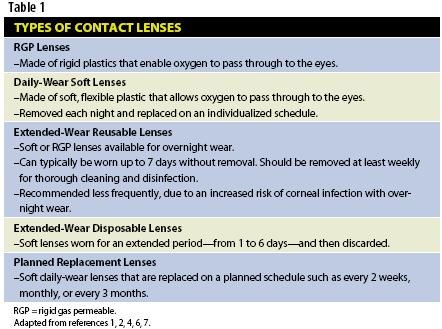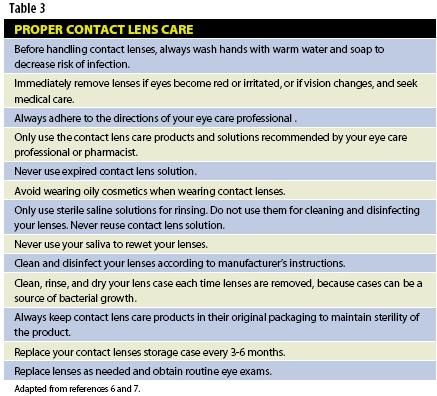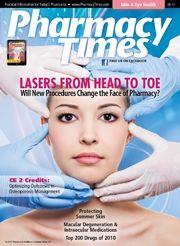Publication
Article
Pharmacy Times
Proper Contact Lens Care
Author(s):
Whether patients wear soft or hard lenses, they need help choosing appropriate products for cleaning and disinfection.
Whether patients wear soft or hard lenses, they need help choosing appropriate products for cleaning and disinfection.

An estimated 72% of the American adult population requires some form of vision correction; of this group, 1 in 7 wear contact lenses.1 Contact lenses decrease size distortion and prismatic effects, improve peripheral vision, and may provide improved acuity in those individuals with irregular or impaired acuity.2 Many individuals elect to use contact lenses because of their comfort and ease of use and to avoid the disadvantages of wearing eyeglasses, which include the fogging of lenses during temperature and humidity changes, dirt accumulation on lenses, and distraction or obstructed vision from eyeglass frames.2
Although contact lenses are safe and widely used by many individuals each day, without proper use, care, and maintenance, many serious ophthalmic problems can occur.1 These include a greater incidence of corneal infection, corneal ulcers, and other ophthalmic disorders, which may result in permanent eye damage and, though rare, blindness.1 Keratitis is the most common infection related to contact lens use.3 In addition to improper care of contact lenses, factors that may increase the incidence of contact lens—related infections include using extended-wear lenses, sleeping in contact lenses, and decreased tear exchange under the lens.3 Fortunately, there are more than 100 OTC products available to assist patients with proper contact lens care.
Types of Contact Lenses
The 2 most basic classifications of contact lenses are soft and hard.1,2,4 Patients may wear a variety of contact lens types (Table 1), including bifocal lenses, multifocal lenses, and toric contacts to correct astigmatism, as well as extended-wear or disposable

contacts that are made for daily, weekly, or monthly use.1-3,5 Soft contact lenses are made of a water-absorbing, flexible plastic often referred to as hydrogel, whereas hard contact lenses are made of a more rigid plastic sometimes referred to as rigid gas permeable (RGP).1-5 It is worth noting that RGPs are different from the earlier generation of hard contacts made from polymethyl methacrylate, which were not oxygen permeable.
Because soft contacts are typically more comfortable, they are more popular compared with hard contact lenses, but soft contact lenses are less durable than RGP lenses and must be handled more carefully.1,2,4 Patients should discuss the available options with their eye care provider to decide which type is best suited for their individual needs.
Pharmacists can be instrumental in assisting contact lens wearers in the appropriate selection of lens care products. Patients who wear RGP lenses will choose from cleaning solutions, enzymatic cleaning products, wetting/soaking/disinfecting solutions, rewetting/lubricating solutions, and multipurpose solutions.2 Products formulated for soft contact lenses include surface-active cleaners, chemical disinfecting solutions, hydrogen peroxide disinfecting solutions, preserved saline solutions, preservative-free saline solutions, rewetting/lubricating solutions, and multipurpose solutions, which act as surface-active cleaners, protein removers, and disinfecting agents.2
Pharmacists are key in identifying those patients who may be at risk for drug—contact lens interactions. These interactions may occur with the use of topical ophthalmic drugs as well as systemic drugs, because many systemic drugs are secreted in tears. 2 Other drugs may alter tear production, the shape of the cornea, refractive properties of the lens, the lens itself, or the size of the pupil. 2 Examples of these drugs can be found in Table 2.

During counseling, patients should be reminded that proper lens care and storage are the most important steps in preventing infections of the eye or other ophthalmic problems (Table 3). Patients should only use those products recommended for their type of contact lenses.
Patients should also be informed to remove lenses before instilling any ophthalmic products not specifically intended for concurrent use with soft contact lenses, and to wait at least 20 to 30 minutes before reinserting lenses, unless otherwise directed by an eye care provider. 2 Patients should also be advised to remove contacts and immediately seek medical care if they experience problems, such as improperly fitting lenses, pain, redness, blurry vision, excessive tearing, increased sensitivity to light, discharge from the eye, or any other signs of infections, to prevent further complications. An excellent patient resource on the proper care of contact lenses can be found on the American Academy of Ophthalmology Web site at www.geteyesmart.org/eyesmart/glasses-contacts-lasik/ contact-lens-care.cfm
Ms. Terrie is a clinical pharmacy writer based in Haymarket, Virginia.
References
1. Understanding contacts. Alcon Web site. www.opti-free.com/contact-lenses.aspx. Accessed April 12, 2011.
2. Engle J. Prevention of contact lens—related disorders. In: Berardi R, Newton G, McDermott JH, et al, eds. Handbook of Nonprescription Drugs. 16th ed. Washington, DC: American Pharmacists Association; 2009:545-568.
3. Contact lens —related eye infections. American Academy of Ophthalmology Web site. www.geteyesmart.org/eyesmart/diseases/contact-lens-related-infections.cfm. Accessed April 12, 2011.
4. Contact lens. Eye Care America Web site. www.aao.org/eyecare/treatment/contact-lenses/index.cfm. Accessed April 12, 2011.
5. Tatham A et al. Contact lens removal. Medscape Web site. http://emedicine.medscape.com/article/1413506-overview#a01. Accessed April 12, 2011.
6. Advantages and disadvantages of various types of contact lenses. American Optometric Association Web site. www.aoa.org/x5234.xml. Accessed April 11, 2011.Contact lens types. American Academy of Ophthalmology Web site. www.geteyesmart.org/eyesmart/glasses-contacts-lasik/contact-lens-types.cfm. Accessed April 12, 2011.
7. Contact solutions and products. Centers for Disease Control Web site. www.fda.gov/MedicalDevices/ProductsandMedicalProcedures/HomeHealthandConsumer/ConsumerProducts/ContactLenses/ucm062584.htm. Accessed April 11, 2011.
8. Everyday eye care. Centers for Disease Control Web site. www.fda.gov/MedicalDevices/ProductsandMedicalProcedures/HomeHealthandConsumer/ConsumerProducts/ContactLenses/ucm062594.htm. Accessed April 12, 2011.







